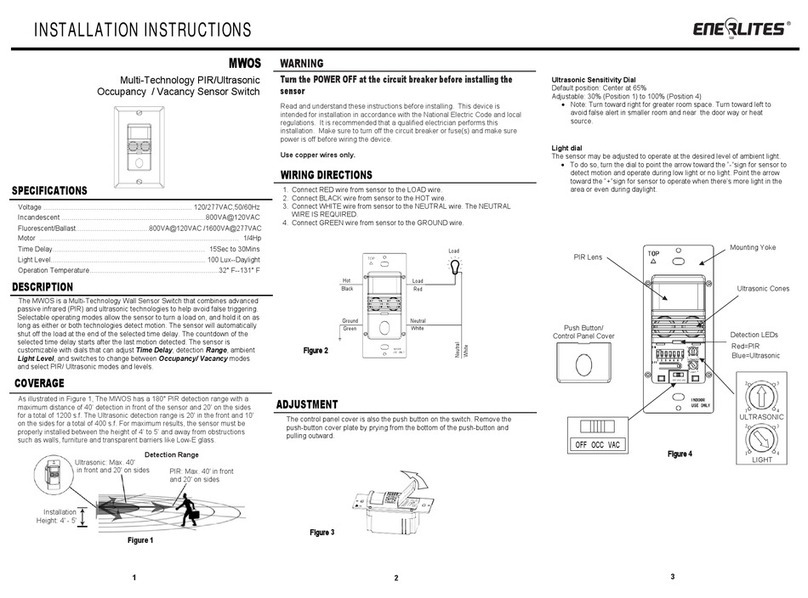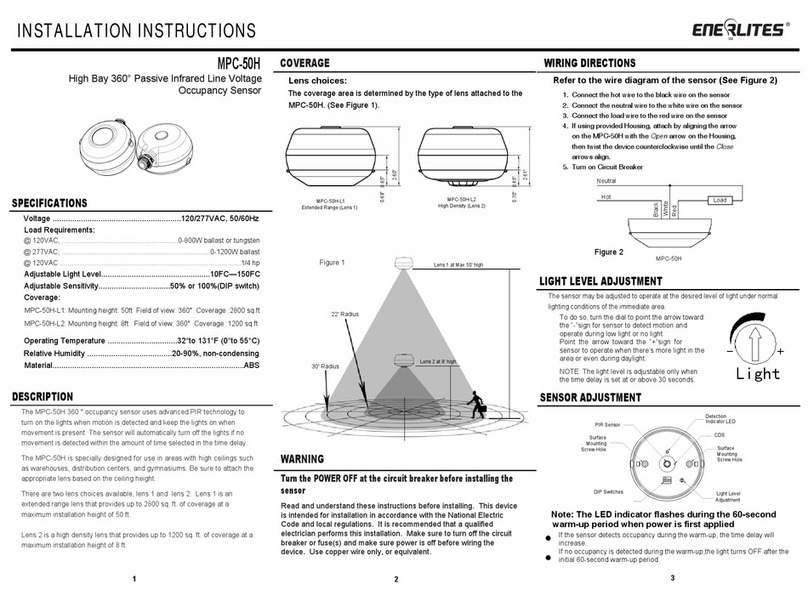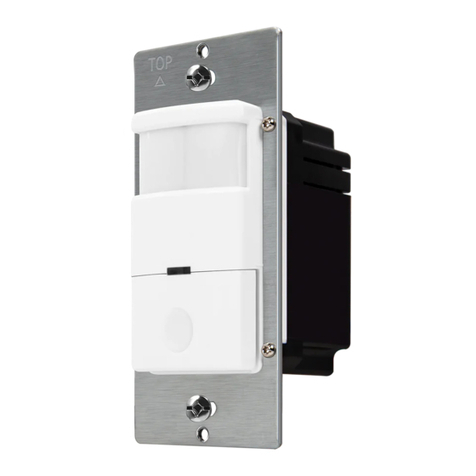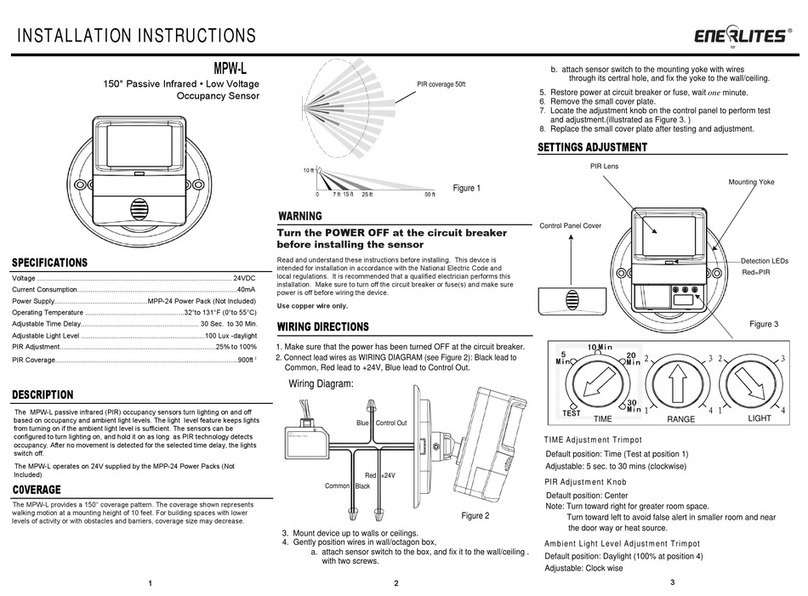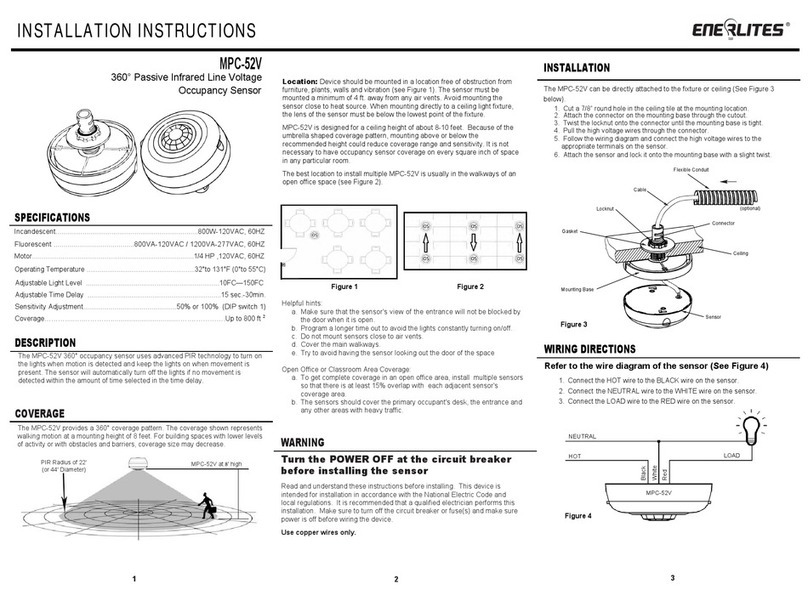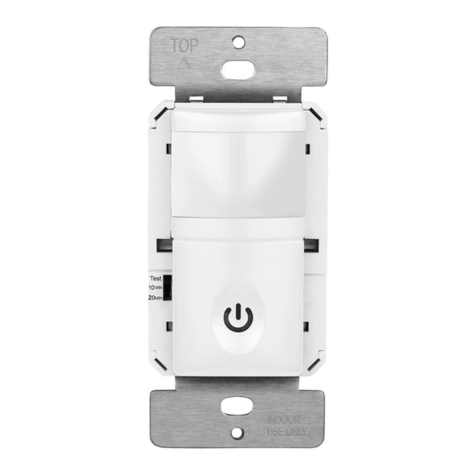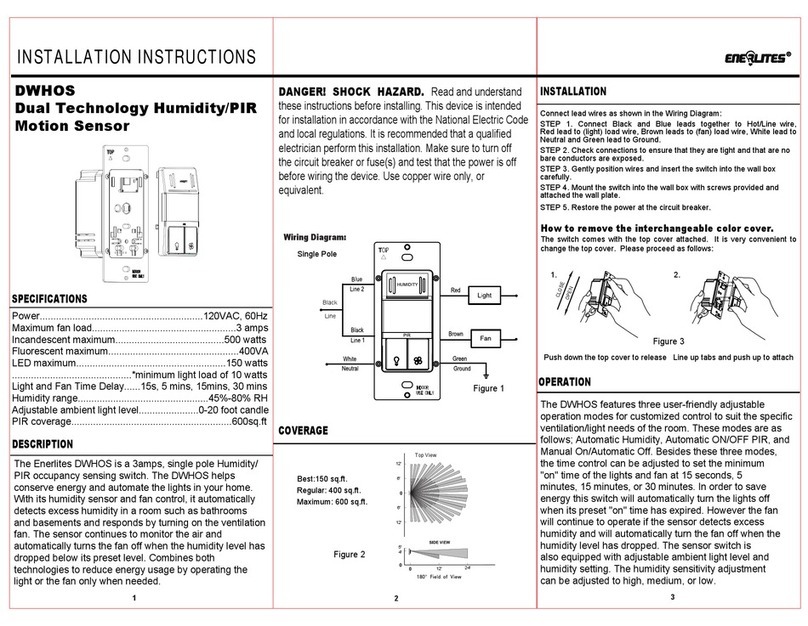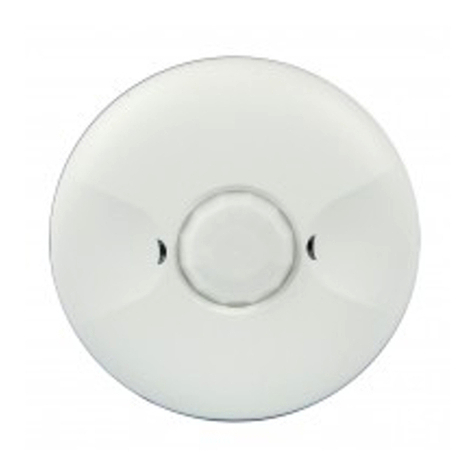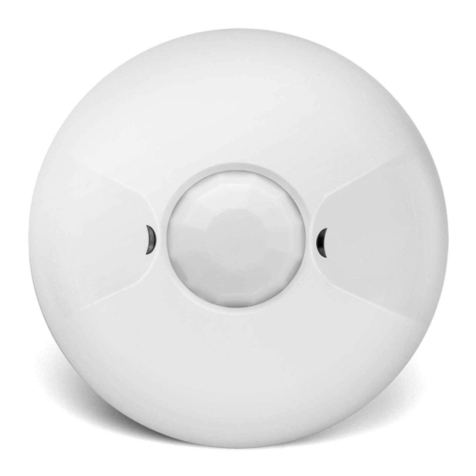
456
© 2016 Enerlites Inc.
CA, U.S.A.
WWW.ENERLITES.COM
0210160046-02
OPERATING THE SENSOR AND RECEPTACLE(S)
Operating
The "Always ON" receptacles will always have power as long as the circuit
breaker is ON. The "Controlled"receptacles will turn ON and stay ON as long
as motion is detected and turn off 30 minutes after the last motion detected.
The "Controlled" receptacle can also be operated manually by pushing the
manual override button located on the receptacle.
Low Battery Indicator
The LED indicator on the sensor will flash constantly when the battery on the
sensor is running low.
WARRANTY INFORMATION
This device is warranted to be free of material and workmanship defects for 2 years from the
date of purchase. Original receipt or proof of purchase from an authorized retailer must be
presented upon warranty claim. ALL claims must be verified and approved by Enerlites, Inc.
Warranties from other Enerlites products may vary. This warranty is nontransferable and
does not cover normal wear and tear or any malfunction, failure, or defect resulting from
misuse, abuse, neglect, alteration, modification, or improper installation. To the fullest extent
permitted by the applicable state law, Enerlites shall not be liable to the purchaser or end
user customer of Enerlites products for direct, indirect, incidental, or consequential damages
even if Enerlites has been advised of the possibility of such damages. Enerlites’ total liability
under this or any other warranty, express or implied, is limited to repair, replacement or
refund. Repair, replacement or refund are the sole and exclusive remedies for breach of
warranty or any other legal theory.
MOUNTING PLBPC
1. Secure the mounting bracket to the ceiling using provided screws, anchors and
double-sided tape.
2. Align the latch on the sensor to the mounting bracket.
3. Latch the sensor by turning it counter-clockwise.
PIR Lens LED Indicator
Button Press Function
Short-press
Long-press( 10 seconds)
Manually turns ON/OFF the controlled
receptacle.
Receptacle enters LEARN mode.
Button Functions on Receptacle:
LED indicator Indication
Flashes rapidly for about 45 seconds
Solid ON for 2 seconds (following Learn mode)
Quick flashes twice, stops 1 second, and then
quick flashes twice (Repeat)
Receptacle is in Learn mode
Receptacle is paired
Device is in trouble mode
LED Indicator on Receptacle:
CODE LEARNING
BEFORE Installing the sensor onto the ceiling, you must pair all
receptacles with the PLBPC ceiling sensor. Six receptacles are
recommended per sensor.
1. Remove the battery from the PLBPC sensor.
2. Power on the receptacles once they're all connected and wall plates are installed.
3. Press and hold the "LEARN" button for 15 seconds on the receptacle.
4. Once the receptacle is in LEARN mode, install both batteries into the PLBPC
sensor. NOTE: The receptacles will be in LEARN mode for about 45 seconds.
5. Wait a few seconds for the receptacle to pair with the PLBPC.
6. Repeat steps 1-5 for each receptacle to be paired (Multiple receptacles can be
paired simultaneously)
7. Test all receptacles to ensure that they're operating correctly.
8. Install ceiling sensor onto ceiling.
Always ON
Receptacle
Controlled
Receptacle
PL20R DIAGRAM
LED Indicator on Sensor will quickly blink 3 times when battery is installed
FCC COMPLIANCE STATEMENT
FCC Grant of Equipment Authorizations of this device and transmitters installed in this device
can be found at FCC website by entering the FCC ID number on the device.
Caution: Changes or modifications not expressly approved by the part responsible for
compliance could void the user’s right to operate the equipment.
This device complies with Part 15 of the FCC Rules. Operation is subject to the following two
conditions: (1) this device may not cause harmful interference, and (2) this device must accept
any interference received, including interference that may cause undesired operation of the
device.
This equipment has been tested and found to comply with the limits for a Class B digital device,
pursuant to part 15 of the FCC rules. These limits are designed to provide reasonable protection
against harmful interference in a residential installation. This equipment generates, uses and can
radiate radio frequency energy and, if not installed and used in accordance with the instructions,
may cause harmful interference to radio communications. However, there is no guarantee that
interference will not occur in a particular installation. If this equipment does cause harmful
interference to radio or television reception, which can be determined by turning the equipment
off and on, the user is encouraged to try to correct the interference by one or more of the
following measures:
•Reorient or relocate the receiving antenna.
•Increase the separation between the equipment and receiver.
•Connect the equipment into an outlet on a circuit different from that to which the receiver is
connected.
•Consult the dealer or an experienced radio/TV technician for help.
